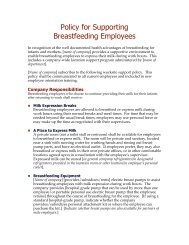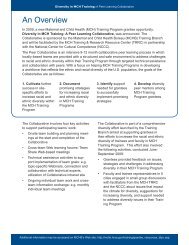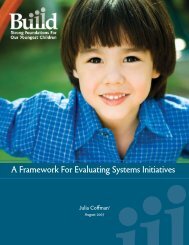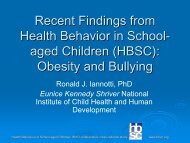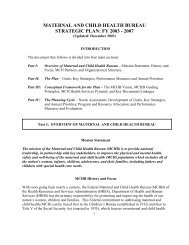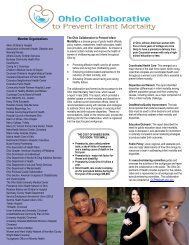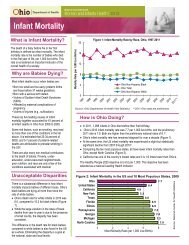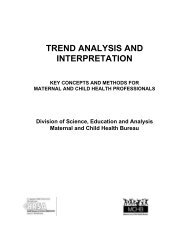improving infant mortality in ohio - Maternal and Child Health ...
improving infant mortality in ohio - Maternal and Child Health ...
improving infant mortality in ohio - Maternal and Child Health ...
Create successful ePaper yourself
Turn your PDF publications into a flip-book with our unique Google optimized e-Paper software.
IMPROVING INFANT MORTALITY IN OHIOThe follow<strong>in</strong>g document is a comb<strong>in</strong>ation of many of our thoughts over the past fewmonths about how to improve <strong><strong>in</strong>fant</strong> <strong>mortality</strong> <strong>in</strong> Ohio. I would like for you to imag<strong>in</strong>ethat we are declar<strong>in</strong>g WAR aga<strong>in</strong>st Infant Mortality. To wage this war, we have tosimultaneously fight on several different Battlefields. In this document, these“battlefields” are represented by different categories like premature birth, congenitalanomalies, etc.Some would suggest that we “pick a few battles”, limit our <strong>in</strong>terventions or just try toimprove one or two of these issues, <strong>and</strong> not take on the entire bunch. I am suggest<strong>in</strong>gthat we figure out how to w<strong>in</strong> EVERY battle. Each area of <strong>in</strong>terest represents amechanism by which newborns do not survive until their first birthday. The recognizedareas not only acknowledge cl<strong>in</strong>ical/medical concerns that identify biological causes of<strong><strong>in</strong>fant</strong> <strong>mortality</strong>, but also attempt to identify up-stream contributors to why babies die.None of them are easy to solve; all require <strong>in</strong>tense, susta<strong>in</strong>ed, committed efforts fromALL of us to have an opportunity to w<strong>in</strong> this war.I am certa<strong>in</strong> my list is not comprehensive, that there are “other” battles we need to wagethat are not considered <strong>in</strong> this document. Please help me to <strong>in</strong>clude other areas requir<strong>in</strong>gour attention.Please also help to provide descriptions/explanations about how each “battlefield”contributes to our challenges to improve <strong><strong>in</strong>fant</strong> <strong>mortality</strong>.Help me to del<strong>in</strong>eate how we best fight each battle…what we need to consider do<strong>in</strong>g tow<strong>in</strong> each battle. What “weapons” we need to employ to give us the best opportunity tobe successful?Can each of these battlefields be assigned to a current OCPIM work-group or do we needto develop additional work-groups? For example, which of our current work-groupsworks to decrease the <strong>in</strong>cidence of congenital anomalies? I do not th<strong>in</strong>k this is an issuewe address thru OCPIM…<strong>and</strong> I th<strong>in</strong>k it should be.Likewise, I th<strong>in</strong>k we need additional recruits to jo<strong>in</strong> our OCPIM army; representativesfrom Family Plann<strong>in</strong>g, legislators, bus<strong>in</strong>ess, government, more grass-root representation,etc.How does this list apply to local communities?If we cont<strong>in</strong>ue consideration for sponsor<strong>in</strong>g an Ohio Infant Mortality Summit <strong>in</strong>November, might we consider our sub-theme the official Ohio declaration of war aga<strong>in</strong>stInfant Mortality?
1. Premature Birth:a. Progesterone Project 34.3% of <strong><strong>in</strong>fant</strong> deaths are ultimately due to preterm birth. 95% of <strong><strong>in</strong>fant</strong> deaths occurred <strong>in</strong> <strong><strong>in</strong>fant</strong>s born before 32 weeks <strong>and</strong>below 1,500 grams birth weight. Women at risk of preterm birth from previous preterm birth orshort cervix can be identified early <strong>in</strong> their pregnancies with avariety of screen<strong>in</strong>g technics. Once identified, treat<strong>in</strong>g these women with 17P, a form ofprogesterone, can significantly extend the weeks of theirpregnancy, result<strong>in</strong>g <strong>in</strong> larger, better-developed babies with agreater chance of survival. Partners <strong>in</strong> the Ohio Collaborative to Prevent Infant Mortality aredevelop<strong>in</strong>g a statewide project to implement this screen<strong>in</strong>g <strong>and</strong>treatment approach to improved birth outcomes. For more <strong>in</strong>formation, contact Jay Iams, MD at the OSU MedicalCenter: Jay.Iams@OSUMC.edu or phone 614-293-8736.b. Scheduled Birth Initiative: OPQC (Ohio Per<strong>in</strong>atal QualityCollaborative: Ohio Per<strong>in</strong>atal Quality Collaborative (OPQC) is a networkof Ohio per<strong>in</strong>atal cl<strong>in</strong>icians, hospitals, state agencies (Ohio Department of<strong>Health</strong>, Ohio Medicaid), <strong>and</strong> policy makers founded <strong>in</strong> 2007. The missionof OPQC is: “through collaborative use of improvement science methods,reduce preterm births <strong>and</strong> improve outcomes of preterm newborns <strong>in</strong> Ohioas quickly as possible.” OPQC improvement efforts target the populationof all Ohio pregnancies <strong>and</strong> all families with women of childbear<strong>in</strong>g age.The first OPQC NICU project aimed to reduce hospital-associated<strong>in</strong>fections (HAI) among preterm <strong><strong>in</strong>fant</strong>s. Among Ohio’s 24 participat<strong>in</strong>gNICUs, <strong>in</strong>fections have been reduced by 20% from 18% to 14%. Insertion<strong>and</strong> ma<strong>in</strong>tenance bundle development <strong>and</strong> use at sites contributed to thisreduction.) The first OPQC OB project aimed to reduce unnecessary, planned,late preterm <strong>and</strong> near term deliveries at 36 to 38 weeks gestationalage. S<strong>in</strong>ce <strong>in</strong>itiat<strong>in</strong>g this OPQC project, more than 18,000 birthshave moved from occurr<strong>in</strong>g prior to the due date to full term (39 to41 weeks). Approximately 500 NICU admissions <strong>and</strong> some <strong><strong>in</strong>fant</strong>deaths have been avoided. Compared to the basel<strong>in</strong>e period beforethis project, this work, by 20 large Ohio maternity hospitals <strong>and</strong>their staffs represents a major, positive transformation ofobstetrical care <strong>in</strong> Ohio <strong>and</strong> at least approximately $10 million <strong>in</strong>annual Ohio health care cost sav<strong>in</strong>gs. Next steps for OPQC <strong>in</strong>clude:1. Dissem<strong>in</strong>at<strong>in</strong>g successful practices from scheduled deliveryproject to the additional 96 hospitals across the state;2. Implement<strong>in</strong>g the next OB improvement project: to ensurethat all pregnant women at risk receive appropriateAntenatal Corticosteroids;
3. Cont<strong>in</strong>u<strong>in</strong>g efforts to decrease rate of bloodstream<strong>in</strong>fections by 1) <strong>in</strong>creas<strong>in</strong>g the reliability of catheter carema<strong>in</strong>tenance bundle use; <strong>and</strong> 2) implement<strong>in</strong>g a bundle toimprove the rate <strong>and</strong> volume of human milk feed<strong>in</strong>g <strong>in</strong>premature <strong><strong>in</strong>fant</strong>s; <strong>and</strong>4. Improv<strong>in</strong>g birth certificate data entry quality <strong>and</strong> use ofvital stats as population health outcome measurec. Assisted Reproductive Technology: (I am not certa<strong>in</strong> what the situation islike <strong>in</strong> Ohio…if there is a limit to the number of eggs used, what thecircumstance is re: selective term<strong>in</strong>ation, how we regulate these issues <strong>in</strong>Ohio).d. Cervical Length Measurement: as a predictor of <strong>in</strong>dividuals at <strong>in</strong>creasedrisk of PTB. If done rout<strong>in</strong>ely,1. When should it be done?2. On whom?3. Who pays?2. Congenital Anomalies:a. Obesity Control Pilot Project Obese women are at higher risk for hav<strong>in</strong>g babies born withserious birth defects such as neural tube defects; heart problems<strong>and</strong> oomphalocele. Congenital anomalies are a lead<strong>in</strong>g cause of<strong><strong>in</strong>fant</strong> <strong>mortality</strong> <strong>in</strong> Ohio. OSU School of Public <strong>Health</strong> <strong>in</strong>tern implemented pilot project <strong>in</strong>two Ohio counties with the highest rate of female obesity. Pilot test<strong>in</strong>g a brief <strong>in</strong>tervention model (5A’s) <strong>in</strong> ODH-fundedWomen <strong>and</strong> Reproductive <strong>Health</strong> Cl<strong>in</strong>ics. Project currently <strong>in</strong> implementation (May 2012) Future plans <strong>in</strong>clude evaluat<strong>in</strong>g staff knowledge <strong>and</strong> skills, <strong>and</strong>evaluat<strong>in</strong>g efficacy of this model for weight control <strong>in</strong> women ofreproductive health age.b. Interconception health card for WIC Projects Ohio Partners for Birth Defects Prevention are develop<strong>in</strong>g a healtheducation card to be used at WIC postpartum visits.c. Metabolic Formula Program ODH removes barriers for pregnant women with <strong>in</strong>born errors ofmetabolism such as PKU to receive metabolic formula, which isexpensive <strong>and</strong> not well covered by health <strong>in</strong>surances. Pregnantwomen with untreated PKU are more likely to have babies withcongenital anomalies.d. Newborn Screen<strong>in</strong>g for Critical Congenital Heart Disease (CCHD) Congenital anomalies account for approximately 20% of the<strong><strong>in</strong>fant</strong>s who die before their first birthday. Of those <strong><strong>in</strong>fant</strong>s whodie from congenital anomalies, greater than 20% die from CCHD.
USHHS Secretary Sebelius added newborn screen<strong>in</strong>g for CCHD tothe national uniform panel of disorders for state newborn screen<strong>in</strong>gprograms <strong>in</strong> 2011. Newborn screen<strong>in</strong>g for CCHD is done by pulse oximetry, a po<strong>in</strong>tof care test completed <strong>and</strong> read at the newborn nursery level. ODH is currently explor<strong>in</strong>g the issues, barriers, etc. of add<strong>in</strong>gnewborn screen<strong>in</strong>g for CCHD to Ohio’s newborn screen<strong>in</strong>g panel.1. Is this budgetary process the time to request fund<strong>in</strong>g to beable to do this?3. Sudden Unexpla<strong>in</strong>ed Infant Deaths:a. Sleep-related Deaths <strong>and</strong> Sudden Unexpla<strong>in</strong>ed Infant Death (SUID) Fifteen percent of all <strong><strong>in</strong>fant</strong> deaths are sleep-related. Of the deaths between 29 days <strong>and</strong> 1 year of age, 42 percent weresleep-related. After the first month, sleep-related death is the biggest threat to ababy’s life the rest of the first year. More than three Ohio <strong><strong>in</strong>fant</strong> deaths each week are sleep-related. We can reduce the <strong>in</strong>cidence of this cause of <strong><strong>in</strong>fant</strong> <strong>mortality</strong> byimplement<strong>in</strong>g the American Academy of Pediatrics (AAP) Safe SleepGuidel<strong>in</strong>es published <strong>in</strong> October, 2011 <strong>and</strong> available at:http://pediatrics.aappublications.org/content/early/2011/10/12/peds.2011-2285)The Ohio Injury Prevention Partnership/<strong>Child</strong> Injury Action Group has identified<strong><strong>in</strong>fant</strong> sleep-related deaths as a priority issue. An action plan has been developedthat <strong>in</strong>cludes: Creat<strong>in</strong>g a statewide subcommittee; Collaborat<strong>in</strong>g with other organizations to conduct a statewide safesleep campaign; Promot<strong>in</strong>g legislative m<strong>and</strong>ates for safe sleep policies <strong>and</strong> parenteducation policies <strong>in</strong> birth<strong>in</strong>g hospitals;o Encourage all providers of prenatal care teach all pregnantwomen about safe sleep.o Just like we currently will not discharge a baby from thehospital if her/his parents do not have a car seat for the ridehome, it is time to “m<strong>and</strong>ate” that hospitals DO NOTdischarge any baby from the hospital without proof thatthe parents have been taught about safe-sleep dur<strong>in</strong>g thepostpartum period of time!• Let us appeal to the CIAG (<strong>Child</strong> Injury Action Group)<strong>and</strong> the OCPIM Policy work-group to design <strong>and</strong> lobbyfor adoption of such a policy.• Encourage that “re<strong>in</strong>forcement education” about safesleepbe a part of newborn evaluations (for the first yearof life).
• Adopt a “uniform” safe sleep message based on10/2011 AAP guidel<strong>in</strong>es.• REQUIRE that safe sleep be a part of the teach<strong>in</strong>g of allprenatal providers. Beg<strong>in</strong> teach<strong>in</strong>g by 24 weeks, before familiesbeg<strong>in</strong> buy<strong>in</strong>g cribs, clothes, etc., for baby. Document that such teach<strong>in</strong>g occurred.• REQUIRE every hospital, nursery, day care center,health care facility to develop a safe sleep policy (oradopt the ODH policy)In each location REQUIRE that safe sleep beutilized <strong>and</strong> therefore modeled with<strong>in</strong> theorganization.• REQUIRE each hospital to have a safe sleep check-listwhich they use to document safe sleep teach<strong>in</strong>g to eachmother prior to be<strong>in</strong>g discharged from the hospital.<strong>Maternal</strong> signature should be required.• Arrange for a home visit for each postpartum motherwith<strong>in</strong> 1-2 weeks of discharge from the hospital.Although there might be a number of issues tobe addressed at the time of this visit (BP, postpartum depression, breastfeed<strong>in</strong>g, etc), one ofhem would be to visually verify the sleepenvironment of the baby <strong>and</strong> to review the cafésleep check list AGAIN (signed aga<strong>in</strong> bymother/parents/caregivers)• Well Baby visit: enforce safe sleep message• Postpartum visit: enforce safe sleep message• Death scene <strong>in</strong>vestigation for any sids or sleep related<strong><strong>in</strong>fant</strong> death.Partner<strong>in</strong>g with retailers to promote safe sleep to customers; <strong>and</strong>Ensur<strong>in</strong>g that prenatal care providers <strong>and</strong> pediatric health careproviders are promot<strong>in</strong>g <strong>and</strong> distribut<strong>in</strong>g safe sleep messages. The subcommittee <strong>in</strong>cludes professionals from many state agencies<strong>and</strong> local health department as well as parent representatives. Thegroup is currently work<strong>in</strong>g with the Ohio chapter of the AmericanAcademy of Pediatrics on plans for a social market<strong>in</strong>g campaign.4. Drug use dur<strong>in</strong>g pregnancy:a. Prescription Medication Importance of preconception care, to optimally “control” chronicillnesses with non-teratogenic medications. To wean off Rx. drugs be<strong>in</strong>g taken by someone other that who theyare prescribed for.b. Illegal Drugs
5. Breastfeed<strong>in</strong>g:a. AAP recommends exclusive breastfeed<strong>in</strong>g for about 6 months, followedby cont<strong>in</strong>ued breastfeed<strong>in</strong>g as complementary foods are <strong>in</strong>troduced, withcont<strong>in</strong>uation of breastfeed<strong>in</strong>g for 1 year or longer as mutually desired bymother <strong>and</strong> <strong><strong>in</strong>fant</strong>.b. Breastfeed<strong>in</strong>g is l<strong>in</strong>ked to decreased risk of SIDS, necrotiz<strong>in</strong>g enterocolitis(NEC), ear <strong>in</strong>fections, GI <strong>in</strong>fections, celiac disease, <strong>in</strong>flammatory boweldisease, obesity, diabetes, childhood leukemia <strong>and</strong> lymphoma, <strong>and</strong> betterneurodevelopmental outcomes. Therefore, feed<strong>in</strong>g artificial baby formulais l<strong>in</strong>ked to <strong>in</strong>creased risk of SIDS, necrotiz<strong>in</strong>g enterocolitis (NEC), ear<strong>in</strong>fections, GI <strong>in</strong>fections, necrotiz<strong>in</strong>g enterocolitis (NEC), SIDS, celiacdisease, <strong>in</strong>flammatory bowel disease, obesity, diabetes, childhoodleukemia <strong>and</strong> lymphoma, <strong>and</strong> better neurodevelopmental outcomes.i. If 90% of families exclusively breastfeed for 6 months, nearly1,000 deaths among <strong><strong>in</strong>fant</strong>s could be prevented.ii. Prematurity largest s<strong>in</strong>gle cause of <strong><strong>in</strong>fant</strong> death. NEC is the mostcommon gastro<strong>in</strong>test<strong>in</strong>al emergency <strong>in</strong> premature <strong><strong>in</strong>fant</strong>s. Byfeed<strong>in</strong>g preterm <strong><strong>in</strong>fant</strong>s human milk, there is a 58% reduction <strong>in</strong>the <strong>in</strong>cidence of NEC.iii. SIDS is the fourth s<strong>in</strong>gle cause of <strong><strong>in</strong>fant</strong> death. The rate of SIDS is60% lower among <strong><strong>in</strong>fant</strong>s who had any breastfeed<strong>in</strong>g versus thosewithout breastfeed<strong>in</strong>g. The rate of SIDS is 70% lower <strong>in</strong>exclusively breastfed <strong><strong>in</strong>fant</strong>s (no formula) for any period of time.c. Ohio breastfeed<strong>in</strong>g rates have been slowly <strong>in</strong>creas<strong>in</strong>g over the past 6years.i. In 2010, 67% of Ohio mothers <strong>in</strong>itiated breastfeed<strong>in</strong>g, but thatfalls short of the <strong>Health</strong>y People 2010 goal of 75%.ii. Ohio has also made progress <strong>in</strong> the number of <strong><strong>in</strong>fant</strong>s who arebreastfed at 6 months of age, almost 40%. However, this also trailsbeh<strong>in</strong>d the US rate of 44% <strong>and</strong> the HP2010 objective of 50%.iii. HP 2020 goals: 81.9% to <strong>in</strong>itiate breastfeed<strong>in</strong>g <strong>and</strong> 60.6% for anybreastfeed<strong>in</strong>g at 6 months of age.d. Rates with<strong>in</strong> racial <strong>and</strong> ethnic subgroups are <strong>in</strong>creas<strong>in</strong>g as well; however,disparities persist. Improv<strong>in</strong>g breastfeed<strong>in</strong>g <strong>in</strong>itiation <strong>and</strong> duration ratesamong all demographic groups can help to reduce health disparities.Accord<strong>in</strong>g to the Centers for Disease Control (CDC), 64.7% of Ohiowhite, non-Hispanic mothers <strong>in</strong>itiate breastfeed<strong>in</strong>g while only 54.1% ofblack, non-Hispanic mothers <strong>in</strong>itiate breastfeed<strong>in</strong>g. By six months postpartum,only 33.4% of Ohio white, non-Hispanic mothers arebreastfeed<strong>in</strong>g <strong>and</strong> only 23.4% of black, non-Hispanic mothers arebreastfeed<strong>in</strong>g. By 12 months, less than 15% of white, non-Hispanicmothers are breastfeed<strong>in</strong>g <strong>and</strong> less than 10% of black, non-Hispanicmothers are breastfeed<strong>in</strong>g. Many barriers have been identified <strong>and</strong> the2011 US Surgeon General’s Call to Action to Support Breastfeed<strong>in</strong>gprovides actions <strong>and</strong> implementation strategies.
http://www.surgeongeneral.gov/library/calls/breastfeed<strong>in</strong>g/calltoactiontosupportbreastfeed<strong>in</strong>g.pdfe. Increas<strong>in</strong>g the percentage of mothers elect<strong>in</strong>g to breastfeed by educat<strong>in</strong>gcl<strong>in</strong>icians, women, <strong>and</strong> hospitals us<strong>in</strong>g the AAP recently releasedguidel<strong>in</strong>es on breastfeed<strong>in</strong>g (3/2012). Accord<strong>in</strong>g to these guidel<strong>in</strong>es, if90% of women breastfed, we could reduce the <strong><strong>in</strong>fant</strong> <strong>mortality</strong> rate by30%.http://pediatrics.aappublications.org/content/129/3/e827.full#contentblockf. Breastfed <strong><strong>in</strong>fant</strong>s have immunological <strong>and</strong> nutritional benefits that <strong><strong>in</strong>fant</strong>swho are not breastfed do not. Benefits of breastfeed<strong>in</strong>g <strong>in</strong>clude improveddevelopmental <strong>and</strong> psychosocial outcomes, <strong>in</strong>creased mother/<strong><strong>in</strong>fant</strong>bond<strong>in</strong>g, reduced risks to the mother, reduced health care costs, lessenvironmental waste <strong>and</strong> reduced <strong><strong>in</strong>fant</strong> <strong>mortality</strong> (American Academy ofPediatrics, 2005). Breastfeed<strong>in</strong>g is l<strong>in</strong>ked to decreased risk of SuddenInfant Death Syndrome (SIDS), necrotiz<strong>in</strong>g enterocolitis (NEC), ear<strong>in</strong>fections, GI <strong>in</strong>fections, necrotiz<strong>in</strong>g enterocolitis (NEC), SIDS, celiacdisease, <strong>in</strong>flammatory bowel disease, obesity, diabetes, childhoodleukemia <strong>and</strong> lymphoma, <strong>and</strong> better neurodevelopmental outcomes.Therefore, feed<strong>in</strong>g artificial baby formula is l<strong>in</strong>ked to <strong>in</strong>creased risk ofSIDS, necrotiz<strong>in</strong>g enterocolitis (NEC), ear <strong>in</strong>fections, GI <strong>in</strong>fections,necrotiz<strong>in</strong>g enterocolitis (NEC), SIDS, celiac disease, <strong>in</strong>flammatory boweldisease, obesity, diabetes, childhood leukemia <strong>and</strong> lymphoma, <strong>and</strong> betterneurodevelopmental outcomes.6. Smok<strong>in</strong>g Cessation: In 2010, one <strong>in</strong> three women <strong>in</strong> Ohio smoked three months beforepregnancy (30.9 percent, PRAMS) In 2009, the percent of women who smoked dur<strong>in</strong>g pregnancy <strong>in</strong> Ohio(19.2) is more than double that of those who smoked dur<strong>in</strong>g pregnancy <strong>in</strong>the United States (9.3)(2009, ODH Vital Statistics) 21.8 percent of women <strong>in</strong> Ohio cont<strong>in</strong>ue or start smok<strong>in</strong>g 2-6 months afterpregnancy (2010, PRAMS) Forty-eight percent (48.1%) of women on Medicaid <strong>in</strong> Ohio smokedbefore <strong>and</strong> dur<strong>in</strong>g pregnancy compared to 18.5 percent of non-Medicaidwomen (2009-2010, PRAMS). In 2006, The Prenatal Smok<strong>in</strong>g Cessation Program (PSCP) launched theOhio Partners for Smoke-Free Families (OH-SFF) <strong>in</strong>itiative to ensureconsistent smok<strong>in</strong>g cessation messages <strong>and</strong> <strong>in</strong>terventions are delivered topregnant <strong>and</strong> postpartum women. Ohio Partners for Smoke-Free Families works with public healthpractitioners implement the 5 A’s USPHS Treat<strong>in</strong>g Tobacco Use <strong>and</strong>Dependence cl<strong>in</strong>ical practice guidel<strong>in</strong>es. The5A’s evidenced-based smok<strong>in</strong>g cessation <strong>in</strong>tervention has beenimplemented <strong>in</strong>to 14 <strong>Child</strong> <strong>and</strong> Family <strong>Health</strong> Services (CFHS) per<strong>in</strong>atal
2. The Ohio Connections for <strong>Child</strong>ren with Special Needs(OCCSN) birth defects <strong>in</strong>formation system promotespreconception/<strong>in</strong>terconception health by develop<strong>in</strong>g <strong>and</strong>distribut<strong>in</strong>g educational materials, <strong>and</strong> promot<strong>in</strong>g BirthDefects Prevention Awareness Month statewide. Exp<strong>and</strong> “Pathways” for <strong>Maternal</strong> <strong>and</strong> <strong>Child</strong> <strong>Health</strong>. Richl<strong>and</strong>County achieved a 30 percent reduction <strong>in</strong> low-weight births <strong>in</strong>targeted populations by us<strong>in</strong>g a Community Pathways Model toimprove care coord<strong>in</strong>ation for women <strong>in</strong> difficult-to-serve areas.1The model, which was developed by the Community <strong>Health</strong>Access Project <strong>in</strong> Richl<strong>and</strong> County, coord<strong>in</strong>ates care for women<strong>and</strong> children with<strong>in</strong> targeted medical “pathways.” One pathway(pregnancy <strong>and</strong> postpartum) employs community health workers toidentify pregnant women early <strong>in</strong> their pregnancies <strong>and</strong> then uses asimple, st<strong>and</strong>ard protocol—or checklist—to identify the barriers toa woman deliver<strong>in</strong>g a full-birth-weight <strong><strong>in</strong>fant</strong>. The model pays forperformance by provid<strong>in</strong>g f<strong>in</strong>ancial <strong>in</strong>centives that are tied toelim<strong>in</strong>at<strong>in</strong>g barriers to achiev<strong>in</strong>g normal-weight births, <strong>and</strong>elim<strong>in</strong>ates duplication among health <strong>and</strong> human services agencies.The model has demonstrated success <strong>in</strong> Richl<strong>and</strong> County (13years), Toledo (four years) <strong>and</strong> C<strong>in</strong>c<strong>in</strong>nati (three years).1. The Kasich adm<strong>in</strong>istration’s Office of <strong>Health</strong>Transformation is <strong>in</strong>vest<strong>in</strong>g $350,000 <strong>and</strong> partner<strong>in</strong>g withIntegrated Professionals for Appalachian <strong>Child</strong>ren (IPAC)<strong>and</strong> the Nationwide <strong>Child</strong>ren’s Hospital’s Partners for Kids(PFK) network to replicate the Community PathwaysModel <strong>in</strong> southeast Ohio. The impact of this program isprofound for mothers <strong>and</strong> babies, <strong>and</strong> for taxpayers.Nationally, every low-weight or preterm birth costs statesbetween $28,000 <strong>and</strong> $40,000 <strong>in</strong> medical care <strong>and</strong> otherrelated costs.2 In Ohio, low-weight births represent onlyabout 10 percent of all Medicaid births but account for over50 percent of all Medicaid birth expenditures. The Richl<strong>and</strong>County Community Pathways Model saved $3 for every $1<strong>in</strong>vested <strong>in</strong> the first year of the program <strong>and</strong> an additional$6 for every $1 <strong>in</strong>vested over the next three years. For more<strong>in</strong>formation see: 2/2/2012 Press Releasec. Quality of care:d. Cost of care:e. Care Coord<strong>in</strong>ation: Gov. Kasich adm<strong>in</strong>istration is tak<strong>in</strong>g action to improve carecoord<strong>in</strong>ation for at-risk mothers <strong>and</strong> children &reduce number ofLBW babies. Examples:1. <strong>Health</strong>y Mothers/<strong>Health</strong>y Babies: can we del<strong>in</strong>eate whereprograms are, how long they have been <strong>in</strong> existence, how
many they each serve annually, how their <strong><strong>in</strong>fant</strong> <strong>mortality</strong>rates compare with general community’s?2. Managed Care by C<strong>in</strong>c<strong>in</strong>nati <strong>Health</strong> Department (? Is thisan OIMRI program?).3. OIMRI (Ohio Infant Mortality Reduction Initiative)a. OIMRI (Ohio Infant Mortality ReductionInitiative): Although I am still learn<strong>in</strong>g about thisprogram, each time I hear about it the <strong><strong>in</strong>fant</strong><strong>mortality</strong> data sounds pretty impressive. Are we ata po<strong>in</strong>t that we can look at each of the 14 OhioCounties that have OIMRI programs <strong>and</strong> compareat least 5 year IMR’s for OIMRI participants withtheir local cohorts?4. The participant counties <strong>in</strong>clude: Allen (Lima), Butler(Middletown), Clark (Spr<strong>in</strong>gfield), Cuyahoga (Clevel<strong>and</strong>),frankl<strong>in</strong> (Columbus), Hamilton (C<strong>in</strong>c<strong>in</strong>nati), Lora<strong>in</strong>(Elyria), Lucas (Toledo), Mahon<strong>in</strong>g (Youngstown),Montgomery (Dayton), Richl<strong>and</strong> (Mansfield), stark(Canton), summit (Akron), Trumbull (Warren) (Have weidentifiesd all of the programs, how long they have been <strong>in</strong>existence, how many they each serve annually, how their<strong><strong>in</strong>fant</strong> <strong>mortality</strong> rates compare with general community’s?)a. How were these locations chosen?b. Seems that each of these programs is based on CaseManagement, <strong>in</strong>clud<strong>in</strong>g home visitation…is thiscorrect?c. If we have enough data to suggest that theseprograms work, then how do we spread them towider areas of the counties the programs alreadyexist <strong>in</strong>?d. Can Medicaid Managed Care adopt these models?f. Different models of care: Group Prenatal Care1. Center<strong>in</strong>g Pregnancy: Can we review the impact ofCenter<strong>in</strong>g <strong>in</strong> Ohio? What is the IMR <strong>in</strong> Center<strong>in</strong>gprograms compared to other local programs serv<strong>in</strong>g asimilar cohort that is not Center<strong>in</strong>g? Summarize the models of care <strong>in</strong> the Strong Smart application. Can we beg<strong>in</strong> to <strong>in</strong>vestigate how strongly ty<strong>in</strong>g women’s care <strong>in</strong>tothe Medical Care Home <strong>in</strong>itiative might look. How all of this ties<strong>in</strong>to however the Affordable Care Act is go<strong>in</strong>g to look <strong>in</strong> Ohio?Importantly, we want to ensure that women have access tohealthcare even when they are not pregnant, <strong>in</strong>clud<strong>in</strong>gpreconception <strong>and</strong> <strong>in</strong>terconception care without copay, whichwill provide an extraord<strong>in</strong>ary opportunity to improve women’s
health not only dur<strong>in</strong>g pregnancy, but before, between, <strong>and</strong>beyond pregnancy <strong>and</strong> across their life course.8. Family Plann<strong>in</strong>g:a. Decrease unwanted/un-<strong>in</strong>tended pregnancies, prolong <strong>in</strong>ter-pregnancy<strong>in</strong>tervalb. Medicaid Family Plann<strong>in</strong>g Expansion /State Plann<strong>in</strong>g Admendment A healthy pregnancy is a planned pregnancy <strong>and</strong> one that does notoccur too close to a previous birth (space at least 18-24 monthsapart). As of January 2012 Ohio became the (? 29, 30 th , or 31 st )State to offer a family plann<strong>in</strong>g waiver, known <strong>in</strong> Ohio as the StatePlann<strong>in</strong>g Amendment (SPA). Ohio Medicaid’s recent expansionof eligibility for family plann<strong>in</strong>g services for men <strong>and</strong> women upto 200% of the FPL (federal poverty level) enables a whole newgroup of Ohioans to ga<strong>in</strong> access to family plann<strong>in</strong>g services thatwill help plan pregnancies, which will result <strong>in</strong> healthier babies.To apply for Medicaid family plann<strong>in</strong>g services, apply onl<strong>in</strong>e athttp://jfs.<strong>ohio</strong>.gov/OHP/consumers/Application.stm or contact yourlocal county department of job <strong>and</strong> family services:http://jfs.<strong>ohio</strong>.gov/County/County_Directory.pdf. Can we work with Medicaid <strong>and</strong> Managed Care Organizations tohelp ensure that women have seamless postpartum transition ontothis SPA w/o a hard stop between the postpartum end of theMedicaid coverage for their pregnancy <strong>and</strong> coverage forpostpartum SAP coverage of contraceptive services? S<strong>in</strong>ce womenwith private <strong>in</strong>surance do not have to re-apply to cont<strong>in</strong>ue theirbenefits after deliver<strong>in</strong>g a baby, is there a way for us not to requirewomen pay<strong>in</strong>g for their births by Medicaid to have to re-applybefore they can take advantage of this benefit? How does the SPA <strong>in</strong>fluence the ACA coverage? How do we assure that ALL mothers who deliver babies haveaccess to family plann<strong>in</strong>g services, <strong>in</strong>clud<strong>in</strong>g those who deliver atCatholic <strong>Health</strong>care Centers where family plann<strong>in</strong>g services arenot as available? My <strong>in</strong>terest is not to underm<strong>in</strong>e CatholicDirectives or to <strong>in</strong>terfere with the Catholic Church, but to becerta<strong>in</strong> that the option of family plann<strong>in</strong>g services are available toeveryone whish<strong>in</strong>g to access such services.1. I am not look<strong>in</strong>g for any type of m<strong>and</strong>ate here, but“community-level partnerships” that provide contraceptiveservices seamlessly/conveniently to women <strong>in</strong>terested <strong>in</strong>receiv<strong>in</strong>g them <strong>and</strong> to do so <strong>in</strong> a manner that respects theCatholic church.9. Policy:a. Should we look to legislatively “m<strong>and</strong>ate” FIMR as a part of CFR Rationale: <strong><strong>in</strong>fant</strong> <strong>mortality</strong> accounts for 66% of all <strong>Child</strong>hooddeath <strong>in</strong> Ohio, so we should have a process that conducts more <strong>in</strong>-
depth <strong>in</strong>vestigation of each <strong><strong>in</strong>fant</strong> (<strong>and</strong> perhaps fetal) death. (Ith<strong>in</strong>k the State of Florida conducts FIMR State-wide, so perhapsthey might be a model for us to study).b. M<strong>and</strong>ate Safe-Sleep education prior to discharge from the hospital.10. Market<strong>in</strong>g: (We have to end the relative silence that exists <strong>in</strong> Ohio about theimportance of <strong><strong>in</strong>fant</strong> <strong>mortality</strong>. On April 4, 2012 the Ohio chapter of the Marchof Dimes released the Ohio 2010 <strong><strong>in</strong>fant</strong> <strong>mortality</strong> rates to 825 media outletsthroughout the State. Only one radio station <strong>in</strong> Clevel<strong>and</strong> responded! While thereare no doubt many reasons for such a lack of <strong>in</strong>terest <strong>in</strong> these numbers (whichwere substantially worse than the prelim<strong>in</strong>ary USA 2010 <strong><strong>in</strong>fant</strong> <strong>mortality</strong> rates.One has to go back to 1995 to f<strong>in</strong>d National <strong><strong>in</strong>fant</strong> <strong>mortality</strong> rates comparable toOhio’s 2010 <strong><strong>in</strong>fant</strong> <strong>mortality</strong> rates). ONE out of 825 media outlets was <strong>in</strong>terested<strong>in</strong> this story. Our silence on this issue makes it impossible to create the“community will” we need to improve these rates.)a. September is Infant Mortality Month. What are we do<strong>in</strong>g?b. Beg<strong>in</strong> a media campaign <strong>in</strong> conjunction with all of the workgroups to havea major Statewide article to distribute about some element of <strong><strong>in</strong>fant</strong><strong>mortality</strong>. With 5 workgroups, this would mean each workgroup would beresponsible for an article every fifth month.c. Challenge ODH to consider the development <strong>and</strong> annual release of a muchmore comprehensive annual document that provides more details about<strong><strong>in</strong>fant</strong> <strong>mortality</strong> <strong>in</strong> our State.11. Decreas<strong>in</strong>g Teen Birth Rate:In Ohio <strong>in</strong> 2010, 2.7 percent of all resident live births were to females between 15<strong>and</strong> 17 years of age. This is slightly lower than <strong>in</strong> previous years (teenagers aged15-17 made up 3.0 percent of live births <strong>in</strong> 2009 <strong>and</strong> 3.2 percent of births <strong>in</strong>2008). Nationally the birth rate for teenagers ages 15-17 decreased from 19.6 per1,000 <strong>in</strong> 2009 to 17.3 per 1,000 <strong>in</strong> 2010, accord<strong>in</strong>g to the National Vital StatisticsSystem. Ohio has also experienced a decl<strong>in</strong>e <strong>in</strong> the teenage birth rate from 2009to 2010, with rates for teenagers aged 15-17 lower than national figures (18.7 per1000 <strong>in</strong> 2009 <strong>and</strong> 15.6 per 1000 <strong>in</strong> 2010). Racial disparities among 15-17 yearolds giv<strong>in</strong>g birth are apparent. The birth rate for white teenagers aged 15-17 <strong>in</strong>Ohio <strong>in</strong> 2010 was 11.4 per 1,000. This compared to 31.5 per 1,000 blackteenagers <strong>and</strong> 29.7 per 1,000 Hispanic teenagers aged 15-17 <strong>in</strong> the same year.The decl<strong>in</strong>e <strong>in</strong> teen births <strong>in</strong> Ohio suggests that programs to prevent teenpregnancy have had a positive effect. But data from the national Youth RiskBehavior Survey (YRBS) do not <strong>in</strong>dicate a significant decl<strong>in</strong>e <strong>in</strong> the percentage ofstudents who have ever had sexual <strong>in</strong>tercourse from 1999 (49.9, 95% CI 46.1-53.7) to 2011 (47.8, 95% CI 45.1-50.6). The percentage of students hav<strong>in</strong>g<strong>in</strong>tercourse <strong>in</strong> the past three months who also used birth control pills to preventpregnancy before the last sexual <strong>in</strong>tercourse did not change between 1993 <strong>and</strong>
2011 (22.8 percent <strong>in</strong> 2011). On the other h<strong>and</strong>, among students hav<strong>in</strong>g<strong>in</strong>tercourse <strong>in</strong> the past three months, the percentage that used either birth controlpills or Depo-Provera <strong>in</strong>creased over the period, from 22.0 percent <strong>in</strong> 1999 to 31.8percent <strong>in</strong> 2011.Ohio’s State <strong>Health</strong> Improvement Plan (SHIP) has identified decreas<strong>in</strong>g birthrates among adolescents as a key strategy of the Infant Mortality/Preterm BirthPriority. Us<strong>in</strong>g the Ohio Adolescent <strong>Health</strong> Partnership Plan as a guide, thefollow<strong>in</strong>g objectives are <strong>in</strong>cluded <strong>in</strong> the SHIP: Increase the number of schools with comprehensive health education<strong>in</strong>clud<strong>in</strong>g reproductive health. Improve the knowledge, skills <strong>and</strong> behavior of health care providers toprovide reproductive health services to adolescents <strong>and</strong> their families. Increase the use of effective <strong>and</strong> appropriate contraception amongadolescents.12. Elim<strong>in</strong>ation of Racial Disparity <strong>in</strong> Birth Outcomes, establish “Parity” as theOhio goal for <strong><strong>in</strong>fant</strong> <strong>mortality</strong>.a. Life Courseb. Social Determ<strong>in</strong>ants of <strong>Health</strong>c. Much more <strong>in</strong>vestment from public health <strong>and</strong> cl<strong>in</strong>ical health has to bemade.d. Consider establishment of REACH teams <strong>in</strong> Ohio REACH: Racial <strong>and</strong> Ethnic Approaches to Community <strong>Health</strong>, is aCDC sponsored approach to assist<strong>in</strong>g local community efforts toimprove <strong><strong>in</strong>fant</strong> <strong>mortality</strong>. At this time there is not a REACHproject <strong>in</strong> the State of Ohio.1. Might we consider develop<strong>in</strong>g a REACH project <strong>in</strong>Frankl<strong>in</strong> County as a next step to the Action Learn<strong>in</strong>gCollaborative of CPH?2. An example of a REACH project occurs <strong>in</strong> GeneseeCounty, Michigan where In 2010 Genesee County recordedits lowest <strong><strong>in</strong>fant</strong> <strong>mortality</strong> rate <strong>in</strong> the last 25 years with anoverall IMR of 5.7/1,000 live births (compared to 9.4 <strong>in</strong>2009), white IMR of 4.8 (compared to 5.2 <strong>in</strong> 2009), <strong>and</strong>black IMR of 7.9 (compared to 20.3 <strong>in</strong> 2009).3. The Genesee County REACH (Racial <strong>and</strong> EthnicApproaches to Community <strong>Health</strong>) 2010 <strong>in</strong>itiative,conducted between 2000 <strong>and</strong> 2007, focused on reduc<strong>in</strong>g<strong><strong>in</strong>fant</strong> <strong>mortality</strong>, particularly the disparity <strong>in</strong> rates amongAfrican Americans <strong>and</strong> European Americans, <strong>in</strong> GeneseeCounty, Michigan. The Community Action Plan (CAP)was derived from a community-based participatory
esearch approach <strong>and</strong> based on a socioecological model.The plan derived both from "bench” science <strong>and</strong> “trench”study with community residents. Its theoretical foundationswere grounded <strong>in</strong> a philosophy of public health as socialjustice <strong>and</strong> based on the underst<strong>and</strong><strong>in</strong>g that culture can beboth protective <strong>and</strong> harmful. No s<strong>in</strong>gle <strong>in</strong>tervention willelim<strong>in</strong>ate racial health disparities. Interventions aimed atreduc<strong>in</strong>g <strong><strong>in</strong>fant</strong> <strong>mortality</strong> must precede, <strong>in</strong>clude, <strong>and</strong> followthe period of pregnancy. Core themes for the work of this<strong>in</strong>itiative <strong>in</strong>cluded foster<strong>in</strong>g community awareness <strong>and</strong>mobilization, enhanc<strong>in</strong>g the “baby care” (medical care <strong>and</strong>social services) system, <strong>and</strong> reduc<strong>in</strong>g racism. The overarch<strong>in</strong>ggoal of the REACH project was to effectcommunity <strong>and</strong> systems change sufficient to improve thelocal <strong><strong>in</strong>fant</strong> <strong>mortality</strong> problem. At the start of the project,African American <strong><strong>in</strong>fant</strong>s <strong>in</strong> Genesee County were dy<strong>in</strong>g ata rate greater than three times that of European American<strong><strong>in</strong>fant</strong>s. Major outcome objectives <strong>in</strong> the project’s logicmodel <strong>in</strong>cluded: (1) reduc<strong>in</strong>g racism; <strong>and</strong> (2) reduction <strong>in</strong><strong><strong>in</strong>fant</strong> <strong>mortality</strong> rates <strong>and</strong> the disparity ratio from 1999-2000 basel<strong>in</strong>e data. Project <strong>in</strong>terventions with<strong>in</strong> thissuccessful model’s three <strong>in</strong>terconnected spheres of activity<strong>in</strong>cluded: community dialogue sessions; undo<strong>in</strong>g racismworkshops; university cultural competency <strong>in</strong> health carecurriculum; African Culture Education DevelopmentCenter; maternal/<strong><strong>in</strong>fant</strong> health advocates; PRIDE(Programs to Reduce Infant Deaths Effectively) medicalservices committee; community media campaign; healthyeat<strong>in</strong>g curriculum; <strong>and</strong> Harambee celebrations. Throughthis multifaceted array of successful practice-based<strong>in</strong>terventions, the REACH Community Action Plancontributed significantly to the decl<strong>in</strong>e <strong>in</strong> the <strong><strong>in</strong>fant</strong><strong>mortality</strong> disparity ratio <strong>and</strong> a historic low rate of AfricanAmerican <strong>and</strong> overall <strong><strong>in</strong>fant</strong> deaths <strong>in</strong> Genesee County.4. The REACH plann<strong>in</strong>g process exam<strong>in</strong>ed racial disparities<strong>in</strong> <strong><strong>in</strong>fant</strong> <strong>mortality</strong> from both “bench” (science) <strong>and</strong>“trench” (community) perspectives. Racial disparities <strong>in</strong><strong><strong>in</strong>fant</strong> <strong>mortality</strong> <strong>in</strong> Genesee County have persisted despiteat least two decades of applied contributions from thecl<strong>in</strong>ical, scientific laboratory, <strong>and</strong> legislative “benches” toreduce these gaps. Although many explanations have beenproposed for the failure of st<strong>and</strong>ard <strong>in</strong>terventions to reduceracial disparities, two of the most compell<strong>in</strong>g explanationshave been central to the REACH project: 1. No s<strong>in</strong>gle<strong>in</strong>tervention is likely to elim<strong>in</strong>ate racial disparities <strong>in</strong> <strong><strong>in</strong>fant</strong>health. Racial disparities arise from multiple factors: poor
outreach to <strong>and</strong> coord<strong>in</strong>ation of public health <strong>and</strong> medicalservices for high-risk patients; <strong>in</strong>formal access barriers toneeded services; cultural barriers that h<strong>in</strong>der access <strong>and</strong>patient adherence to beneficial health behaviors; structural<strong>in</strong>equalities that promote poverty <strong>and</strong> communitydislocation; <strong>and</strong> <strong>in</strong>ternalized racism that fosters desperation<strong>and</strong> spiritual exhaustion <strong>in</strong> those communities at greatestrisk. 2. The period of pregnancy is simply too short toaddress effectively many risk factors important to <strong><strong>in</strong>fant</strong>health. A life-course perspective that focuses on improvedmaternal health is essential to improve birth outcomes <strong>in</strong>the African American population. From this perspective,effective <strong><strong>in</strong>fant</strong> <strong>mortality</strong> prevention requires varied<strong>in</strong>terventions that go beyond prenatal or postpartum cl<strong>in</strong>icalcare, to <strong>in</strong>clude primary prevention well before firstpregnancies; preconceptional care for planned pregnancies;postnatal <strong>in</strong>tervention to prevent adverse outcomes amongnewborns <strong>and</strong> older <strong><strong>in</strong>fant</strong>s <strong>and</strong> also to provide primaryprevention for future pregnancies <strong>and</strong> to <strong>in</strong>crease <strong>in</strong>tervalsbetween pregnancies. Given the multifaceted nature of thispublic health problem, multifaceted solutions are required.The Genesee County REACH <strong>in</strong>itiative set <strong>in</strong> motion acomprehensive <strong>and</strong> susta<strong>in</strong>able process to improvematernal <strong>and</strong> <strong><strong>in</strong>fant</strong> health rather than provide for a specifichigh-profile <strong>in</strong>tervention <strong>in</strong> the hope of dramatic short-termga<strong>in</strong>s.5. With a vision of "Better Life Through Better <strong>Health</strong>" <strong>and</strong> amission to protect <strong>and</strong> promote the community's health, theGenesee County <strong>Health</strong> Department (GCHD) was asked byits community partners to serve as the Central Coord<strong>in</strong>at<strong>in</strong>gOrganization (CCO) because of its experience <strong>and</strong>recognized success <strong>in</strong> facilitative, coord<strong>in</strong>at<strong>in</strong>g roles <strong>and</strong> itsleadership <strong>in</strong> community-based public health work. TheGCHD has broad experience as a coord<strong>in</strong>ator of <strong>and</strong>participant <strong>in</strong> community-based work <strong>and</strong> as a catalyst forplann<strong>in</strong>g <strong>and</strong> implement<strong>in</strong>g change <strong>in</strong> public healthpractice, academic tra<strong>in</strong><strong>in</strong>g, <strong>and</strong> community-based work.The membership of the Genesee County REACH Coalitionhas been composed of 10 core partners over the past sevenyears: (1) the Genesee County <strong>Health</strong> Department; (2)University of Michigan-School of Public <strong>Health</strong>-AnnArbor, (3) University of Michigan-Fl<strong>in</strong>t; (4) Faith Accessto Community Economic Development; (5) the GreaterFl<strong>in</strong>t <strong>Health</strong> Coalition; (6) Genesee County CommunityAction Resource Department; (7) PRIDE (Programs toReduce Infant Deaths Effectively) Medical Services
Committee; (8) Fl<strong>in</strong>t Odyssey House <strong>Health</strong> AwarenessCenter; (9) Priority <strong>Child</strong>ren; <strong>and</strong> (10) Fl<strong>in</strong>t Family Road.The coalition adheres to the pr<strong>in</strong>ciples of community-basedresearch developed by the University of Michigan Schoolof Public <strong>Health</strong> <strong>and</strong> adopted by the Prevention ResearchCenter of Michigan. RESPECTFUL represents theapproach that steers community-based participatoryresearch <strong>in</strong> Genesee County: Respect each other’scontributions; Encourage change <strong>and</strong> promote knowledge<strong>in</strong> ways that benefit communities; Share credit <strong>and</strong>responsibility for results; Promote an emphasis on locallyrelevant health issues; Exam<strong>in</strong>e the social, economic, <strong>and</strong>cultural <strong>in</strong>fluences on health; Collaborate on all majorphases of the research process; Treat research participantsethically; Furnish results to the community <strong>in</strong> a usefulmanner; Utilize community strengths <strong>and</strong> expertise; <strong>and</strong>L<strong>in</strong>k research to action to enhance community capacity. Inits role as the CCO, the GCHD had responsibility formanagement <strong>and</strong> oversight of the REACH CAP.Community-based partners have been responsible forguid<strong>in</strong>g the "trench" work, which expla<strong>in</strong>ed dur<strong>in</strong>g theplann<strong>in</strong>g phase why the disparity cont<strong>in</strong>ued to exist despitetwo decades of contributions from the "bench". Reasons<strong>in</strong>cluded problems of language, communication, trust,culture <strong>and</strong> racism. Partners helped to l<strong>in</strong>k “bench” <strong>and</strong>“trench” by build<strong>in</strong>g shared language <strong>and</strong> trust to promoteimproved underst<strong>and</strong><strong>in</strong>g <strong>and</strong> communication, while at thesame time address<strong>in</strong>g structural problems <strong>in</strong> <strong>in</strong>stitutions<strong>and</strong> systems to accomplish the goal of reduc<strong>in</strong>g AfricanAmerican <strong><strong>in</strong>fant</strong> <strong>mortality</strong> <strong>and</strong> racial disparity.6. Dur<strong>in</strong>g the first year of implementation, the GeneseeCounty REACH project was funded at $988,968, <strong>in</strong>clud<strong>in</strong>g$37,631 <strong>in</strong> <strong>in</strong>-k<strong>in</strong>d contributions. In subsequent years (2-7),the fund<strong>in</strong>g was reduced to $912,062 <strong>in</strong>clud<strong>in</strong>g $28,595 <strong>in</strong><strong>in</strong>-k<strong>in</strong>d contributions.7. The REACH plann<strong>in</strong>g process exam<strong>in</strong>ed racial disparities<strong>in</strong> <strong><strong>in</strong>fant</strong> <strong>mortality</strong> from both “bench” (science) <strong>and</strong>“trench” (community) perspectives. Racial disparities <strong>in</strong><strong><strong>in</strong>fant</strong> <strong>mortality</strong> <strong>in</strong> Genesee County have persisted despiteat least two decades of applied contributions from thecl<strong>in</strong>ical, scientific laboratory, <strong>and</strong> legislative “benches” toreduce these gaps. Although many explanations have beenproposed for the failure of st<strong>and</strong>ard <strong>in</strong>terventions to reduceracial disparities, two of the most compell<strong>in</strong>g explanationshave been central to the REACH project: 1. No s<strong>in</strong>gle<strong>in</strong>tervention is likely to elim<strong>in</strong>ate racial disparities <strong>in</strong> <strong><strong>in</strong>fant</strong>
health. Racial disparities arise from multiple factors: pooroutreach to <strong>and</strong> coord<strong>in</strong>ation of public health <strong>and</strong> medicalservices for high-risk patients; <strong>in</strong>formal access barriers toneeded services; cultural barriers that h<strong>in</strong>der access <strong>and</strong>patient adherence to beneficial health behaviors; structural<strong>in</strong>equalities that promote poverty <strong>and</strong> communitydislocation; <strong>and</strong> <strong>in</strong>ternalized racism that fosters desperation<strong>and</strong> spiritual exhaustion <strong>in</strong> those communities at greatestrisk. 2. The period of pregnancy is simply too short toaddress effectively many risk factors important to <strong><strong>in</strong>fant</strong>health. A life-course perspective that focuses on improvedmaternal health is essential to improve birth outcomes <strong>in</strong>the African American population. From this perspective,effective <strong><strong>in</strong>fant</strong> <strong>mortality</strong> prevention requires varied<strong>in</strong>terventions that go beyond prenatal or postpartum cl<strong>in</strong>icalcare, to <strong>in</strong>clude primary prevention well before firstpregnancies; preconceptional care for planned pregnancies;postnatal <strong>in</strong>tervention to prevent adverse outcomes amongnewborns <strong>and</strong> older <strong><strong>in</strong>fant</strong>s <strong>and</strong> also to provide primaryprevention for future pregnancies <strong>and</strong> to <strong>in</strong>crease <strong>in</strong>tervalsbetween pregnancies. Given the multifaceted nature of thispublic health problem, multifaceted solutions are required.The Genesee County REACH <strong>in</strong>itiative set <strong>in</strong> motion acomprehensive <strong>and</strong> susta<strong>in</strong>able process to improvematernal <strong>and</strong> <strong><strong>in</strong>fant</strong> health rather than provide for a specifichigh-profile <strong>in</strong>tervention <strong>in</strong> the hope of dramatic short-termga<strong>in</strong>s.8. Eight years prior to the REACH <strong>in</strong>itiative, <strong>in</strong> 1992, theGCHD was the coord<strong>in</strong>at<strong>in</strong>g organization of a partnershipwith the University of Michigan School of Public <strong>Health</strong>,University of Michigan-Fl<strong>in</strong>t, <strong>and</strong> six predom<strong>in</strong>atelyAfrican-American-led community-based organizations whotogether worked <strong>and</strong> identified themselves as the BroomeTeam. The Broome Team was part of a four-year <strong>in</strong>itiativeto change public health professional education <strong>and</strong> practice.This was accomplished by l<strong>in</strong>k<strong>in</strong>g practitioners <strong>and</strong>academia <strong>in</strong> partnerships with community-basedorganizations, thereby enhanc<strong>in</strong>g the ability of publichealth systems to address societal health issues, particularly<strong>in</strong> multicultural communities. Funded <strong>in</strong> 1992 as part of theW.K. Kellogg (WKK) Foundation's Community-BasedPublic <strong>Health</strong> (CBPH) Initiative, this project has led toimproved social <strong>and</strong> preventive health services through<strong>in</strong>novative programs <strong>and</strong> approaches <strong>in</strong>corporat<strong>in</strong>gcommunity residents as equal partners <strong>in</strong> efforts to design<strong>and</strong> improve the public's health. An Institute of Medic<strong>in</strong>e
eport featured the Broome Team <strong>in</strong> a section aboutcommunity collaboration: "Over the four years of theCBPH partnership, wide gaps <strong>in</strong> culture, race, trust,orientation, <strong>and</strong> history have been bridged among teammembers whose experience work<strong>in</strong>g jo<strong>in</strong>tly now forms thefoundation for work with an exp<strong>and</strong>ed network ofcommunity residents <strong>and</strong> organizations." In the evaluator'sreport back to WKK, the Broome team was described as "abeacon of hope for others who believe that healthycommunities can be created with<strong>in</strong> a common visionthrough respectful, effective partnerships." When the WKKfund<strong>in</strong>g ended <strong>in</strong> 1996, the partners cont<strong>in</strong>ued to meetregularly <strong>and</strong> work on projects at their own expense <strong>in</strong>order to susta<strong>in</strong> the commitment <strong>and</strong> relationshipsdeveloped. It was upon this foundation that the GeneseeCounty REACH <strong>in</strong>itiative was built. As testament to thesusta<strong>in</strong>ability of the REACH <strong><strong>in</strong>fant</strong> <strong>mortality</strong> <strong>and</strong> healthdisparity work, the project was just refunded for anotherfive years, through 2012, <strong>and</strong> designated as a Center ofExcellence <strong>in</strong> the Elim<strong>in</strong>ation of <strong>Health</strong> Disparities underthe CDC’s REACH US program. Some REACH 2010<strong>in</strong>terventions have become “<strong>in</strong>stitutionalized” with<strong>in</strong> theregular programm<strong>in</strong>g <strong>and</strong> operat<strong>in</strong>g budgets of partneragencies. Some are now be<strong>in</strong>g supported by philanthropicgrant resources. Opportunities to leverage furthercommunity <strong>and</strong> f<strong>in</strong>ancial commitments cont<strong>in</strong>ue to bepursued.13. Education:a. FIMR Teams: Fetal <strong>and</strong> Infant Mortality Review Teams Currently two Counties <strong>in</strong> Ohio with FIMR teams (Cuyahoga <strong>and</strong>Hamilton). Dr. Cynthia Shellhaas (OSU/ODH), Lisa Holloway (MoD), ArthurJames (OSU/NCH/ODH) <strong>in</strong>terested <strong>in</strong> develop<strong>in</strong>g this concept forOhio. Consider mak<strong>in</strong>g a subset of CFR Processb. Education Work-group: F<strong>in</strong>d best Statewide models for us to consider emulat<strong>in</strong>g…1. California, NY, Florida, M<strong>in</strong>nesota, others.c. Monthly discussion with LDH’s about relevant <strong><strong>in</strong>fant</strong> <strong>mortality</strong> topics.d. “<strong>Health</strong> Alerts”14. Best Baby Zones:
(The follow<strong>in</strong>g explanation was taken from a plann<strong>in</strong>g grant submitted to Kelloggfoundation by Dr. Michael Lu (Mario Drummond, Magda Peck, Cheri Pies,Milton Kotelchuck) on 5/12/2010 for consideration of establish<strong>in</strong>g BBZ). Thisconcept hosted it’s <strong>in</strong>augural meet<strong>in</strong>g <strong>in</strong> New Orleans, Louisiana dur<strong>in</strong>g the weekof 7/16/2012 <strong>and</strong> is launch<strong>in</strong>g <strong>in</strong> four cities (C<strong>in</strong>c<strong>in</strong>nati, Ohio; Milwaukee,Wiscons<strong>in</strong>; New Orleans, Louisiana; <strong>and</strong> a city <strong>in</strong> northern California)a. Goal: To elim<strong>in</strong>ate disparities <strong>in</strong> child <strong>and</strong> family healthb. Objective: Establish (10) Kellogg Best Babies Zones (BBZs), with the first<strong>and</strong> primary objective of clos<strong>in</strong>g the <strong><strong>in</strong>fant</strong> <strong>mortality</strong> gap <strong>in</strong> participat<strong>in</strong>gcommunities <strong>in</strong> 10 years.c. Background: Despite advancements <strong>in</strong> cl<strong>in</strong>ical medic<strong>in</strong>e <strong>and</strong> public health,racial-ethnic <strong>and</strong> socioeconomic disparities <strong>in</strong> child <strong>and</strong> family health persist.A new, bold, transformative approach is needed. Our system of care is fragmented at best; we spend more <strong>in</strong> the U.S.but achieve less The racial-ethnic <strong>and</strong> socio-economic <strong>in</strong>equities <strong>in</strong> health are mirrored<strong>in</strong> the <strong>in</strong>equities <strong>in</strong> the conditions <strong>and</strong> environments <strong>in</strong> which peoplelive We must take health promotion beyond cl<strong>in</strong>ical care While the first <strong>and</strong> primary objective of the BBZ is to close the <strong><strong>in</strong>fant</strong><strong>mortality</strong> gap <strong>in</strong> 10 years, BBZ is also designed to close the gaps <strong>in</strong>child obesity, asthma, developmental delays, etc. because the same<strong>in</strong>equities that create the <strong><strong>in</strong>fant</strong> <strong>mortality</strong> gap also contribute todisparities <strong>in</strong> child <strong>and</strong> family health. The health gap <strong>in</strong> MCH is an underappreciated contributor to theachievement gap <strong>in</strong> schools that is a cause of poor productivity, higherrate of poverty <strong>and</strong> other national <strong>and</strong> social ills; clos<strong>in</strong>g the health gap<strong>in</strong> MCH is an important prerequisite to clos<strong>in</strong>g the achievement gapd. Approach: Multi-level, multi-sectoral, <strong>and</strong> life-course Multi-level: not only <strong>in</strong>dividual, but family, community, systems, <strong>and</strong>policy Multi-sectoral: not only health development, but educational,economic, <strong>and</strong> community development Life-course: not only disease prevention, but health promotion <strong>and</strong>optimization over the life course, with strategic <strong>in</strong>vestments <strong>in</strong>sensitive periods. We are creat<strong>in</strong>g “pipel<strong>in</strong>es” to health.e. Conceptual Frameworks Ecological model <strong>and</strong> social determ<strong>in</strong>ants <strong>Health</strong> Equity Life-course health development
f. Design Systems approach <strong>in</strong> a def<strong>in</strong>ed geographical areas Prototypes <strong>in</strong> Michigan, Mississippi, New Mexico, Louisiana, NewYork, <strong>and</strong> California Zones def<strong>in</strong>ed by census tracts <strong>and</strong>/or school districts with1. Large health gap <strong>in</strong> maternal <strong>and</strong> child health2. high level of community read<strong>in</strong>ess3. potential to succeed Place-based Community-driven Local Resource Center/Network approach Nations that have successfully achieved similar goals have anchoredcommunity <strong>in</strong>terventions to a “Sure Start” center, or neighborhoodnetwork Collaborative Innovation Network (COIN)1. Sites serve as prototype <strong>in</strong> their local communities <strong>and</strong> ascenters of <strong>in</strong>novation2. Sites l<strong>in</strong>ked <strong>in</strong>to a collaborative learn<strong>in</strong>g <strong>and</strong> <strong>in</strong>novationnetwork to support cross-site learn<strong>in</strong>g, <strong>in</strong>novation <strong>and</strong>improvement strategies Common outcomes framework with local customizationg. Interventions Focus on 4 developmental strategies1. <strong>Health</strong> development2. Educational development3. Economic development4. Community developmenth. <strong>Health</strong> Development Goal: To elim<strong>in</strong>ate disparities <strong>in</strong> child <strong>and</strong> family health Objective: To close the <strong><strong>in</strong>fant</strong> <strong>mortality</strong> gap <strong>in</strong> BBZs <strong>in</strong> 10 years Major Outcomes1. 90% of births <strong>in</strong> BBZ are <strong>in</strong>tended at conception2. 90% of pregnant women <strong>in</strong> BBZ received preconception care3. 90% of pregnant women <strong>in</strong> BBZ received quality prenatal <strong>and</strong><strong>in</strong>trapartum care4. 90% of pregnant/postpartum women <strong>in</strong> BBZ identified with aproblem (e.g. depression) receive care/support5. 90% of women <strong>in</strong> BBZ have a medical home before, between,<strong>and</strong> beyond pregnancy6. 90% of women <strong>in</strong> BBZ asked about their reproductive life planby a healthcare provider <strong>in</strong> the past year
7. 90% of women of childbear<strong>in</strong>g age <strong>in</strong> BBZ engage <strong>in</strong> healthpromot<strong>in</strong>gbehaviors daily (e.g. diet, exercise, <strong>in</strong>take ofmultivitam<strong>in</strong> conta<strong>in</strong><strong>in</strong>g folic acid)8. 90% of mothers <strong>in</strong> BBZ <strong>in</strong>itiate breastfeed, 50% breastfeed <strong>in</strong> 6months, 25% breastfeed <strong>in</strong> 12 months9. 80% of women of childbear<strong>in</strong>g age <strong>in</strong> BBZ are normal weight10. 90% of parents <strong>in</strong> BBZ are asked if they have concerns at thewell-child visit11. 90% of children <strong>in</strong> BBZ assessed with structural screen<strong>in</strong>gtools by pediatrician12. 90% reduction <strong>in</strong> healthcare costs <strong>in</strong> BBZ related to healthdisparities for child <strong>and</strong> family13. 90% of youths <strong>in</strong> BBZ engage <strong>in</strong> health-promot<strong>in</strong>g behaviorsdaily (e.g. diet, exercise) <strong>and</strong> avoid risky health behaviors (e.g.smok<strong>in</strong>g, alcohol or drug use, unsafe sex).14. 80% of youths <strong>in</strong> BBZ are normal weight Change Concepts1. Preconception <strong>and</strong> <strong>in</strong>terconception care2. Quality improvement <strong>in</strong> prenatal <strong>and</strong> <strong>in</strong>trapartum care (e.g.Breakthrough series)3. Systems <strong>in</strong>tegration (e.g. Patient-Centered Medical Home,Family Resource Center) <strong>and</strong> service redesign (e.g. Center<strong>in</strong>g)<strong>and</strong> coord<strong>in</strong>ation (e.g. Nurse Family Partnership; promotora)4. “Pipel<strong>in</strong>e to health”: Pipel<strong>in</strong>e for health promotion <strong>and</strong>optimization with multiple entry po<strong>in</strong>ts (middle <strong>and</strong> highschools, preconception, pregnancy, <strong>in</strong>terconception/earlychildhood)5. Cost control platform: Need to demonstrate that redesign willreduce or control healthcare costs Educational Development1. Goal: To elim<strong>in</strong>ate disparities <strong>in</strong> child <strong>and</strong> family health2. Objective: To close the educational achievement gap <strong>in</strong> BBZs<strong>in</strong> 10 years3. Major Outcomesa. 90% of new parents <strong>in</strong> BBZ attended parent<strong>in</strong>geducation classesb. 90% of new parents <strong>in</strong> BBZ are ready to parentc. 90% of children <strong>in</strong> BBZ read to dailyd. 90% of children/families <strong>in</strong> BBZ receive enrichmentsupport from appropriate community resources (e.g.libraries, family resource centers, play groups)e. 90% of children <strong>in</strong> BBZ are <strong>in</strong> a quality early childhoodeducation sett<strong>in</strong>g with emphasis on resilience-build<strong>in</strong>g<strong>and</strong> problem-solv<strong>in</strong>g
f. 90% of children referred to specialized agenciescomplete the <strong>in</strong>itial <strong>in</strong>take processg. 90% of children <strong>in</strong> BBZ have shared management plansacross agenciesh. 90% of youths <strong>in</strong> BBZ are <strong>in</strong> quality youthdevelopment programsi. 90% of youths <strong>in</strong> BBZ complete high school <strong>and</strong> go onto college Change Concepts1. “Baby college”: parent<strong>in</strong>g education start<strong>in</strong>g before birth2. Quality early child education: with greater emphasis onresilience build<strong>in</strong>g <strong>and</strong> problem-solv<strong>in</strong>g (e.g. Ypsilantipreschool program);3. System <strong>in</strong>tegration <strong>and</strong> service redesign/coord<strong>in</strong>ation: (e.g.<strong>in</strong>tegrat<strong>in</strong>g Early Head Start/Head Start with <strong>Health</strong>y Start orother per<strong>in</strong>atal home visit<strong>in</strong>g programs)4. “Pipel<strong>in</strong>e to success”: ak<strong>in</strong> to Harlem <strong>Child</strong>ren’s Zone withmultiple entry po<strong>in</strong>ts (e.g. baby college, early childhoodeducation, “Promise Academy”, youth development, etc.), butstarts earlier <strong>and</strong> supports youth development with after-school,summer-school, <strong>and</strong> other pipel<strong>in</strong>e programs);5. <strong>Health</strong> promotion: <strong>in</strong>tegrated throughout educational curricula<strong>and</strong> through full-service school health cl<strong>in</strong>ici. Economic development Goal: To elim<strong>in</strong>ate disparities <strong>in</strong> child <strong>and</strong> family health Objective: To reduce poverty rate by 50% <strong>in</strong> BBZ <strong>in</strong> 10 years bycreat<strong>in</strong>g pipel<strong>in</strong>e from poverty to prosperity Major Outcomes1. 95% of middle <strong>and</strong> high school students <strong>in</strong> BBZ participate <strong>in</strong>classes focused on teach<strong>in</strong>g skills for achiev<strong>in</strong>g <strong>and</strong>ma<strong>in</strong>ta<strong>in</strong><strong>in</strong>g f<strong>in</strong>ancial stability <strong>and</strong> security2. 95% of parents <strong>in</strong> BBZ participate <strong>in</strong> classes to <strong>in</strong>crease theirskills for achiev<strong>in</strong>g <strong>and</strong> ma<strong>in</strong>ta<strong>in</strong><strong>in</strong>g f<strong>in</strong>ancial stability <strong>and</strong>security, <strong>and</strong> have a f<strong>in</strong>ancial plan (e.g. money management,sav<strong>in</strong>gs) for their family3. 95% of middle <strong>and</strong> high school students <strong>in</strong> BBZ engaged <strong>in</strong>pipel<strong>in</strong>e to success or pipel<strong>in</strong>e to prosperity programs4. 90% of children/families <strong>in</strong> BBZ requir<strong>in</strong>g safety net servicesreceive high quality, well-coord<strong>in</strong>ated services5. 95% of workforce <strong>in</strong> BBZ employed <strong>in</strong> stable employment thatpays a liv<strong>in</strong>g wage6. 50% reduction <strong>in</strong> the percentage of children <strong>in</strong> BBZ liv<strong>in</strong>g <strong>in</strong>poor households
7. 90% of families <strong>in</strong> BBZ move up by one <strong>in</strong>come qu<strong>in</strong>tile <strong>in</strong> adecade Change concepts1. F<strong>in</strong>ancial stability <strong>and</strong> job read<strong>in</strong>ess: promot<strong>in</strong>g f<strong>in</strong>ancialstability <strong>and</strong> security <strong>and</strong> job read<strong>in</strong>ess with multiple entrypo<strong>in</strong>ts along the “pipel<strong>in</strong>e to prosperity”, start<strong>in</strong>g early <strong>in</strong>middle <strong>and</strong> high schools with f<strong>in</strong>ancial stability tra<strong>in</strong><strong>in</strong>g <strong>and</strong>pipel<strong>in</strong>e programs.2. Safety net programs: creat<strong>in</strong>g a high-function<strong>in</strong>g, wellcoord<strong>in</strong>atedsystem of safety net programs (e.g. TANF,hous<strong>in</strong>g, food stamps, healthcare, childcare etc).3. Microf<strong>in</strong>ance: provid<strong>in</strong>g microloans to support localentrepreneurialship.4. Job creation: stimulat<strong>in</strong>g job creation <strong>and</strong> creat<strong>in</strong>g a stable jobbase with<strong>in</strong> BBZs with economic <strong>in</strong>centives.5. Policy <strong>and</strong> advocacy: <strong>in</strong>creas<strong>in</strong>g local capacity <strong>and</strong> collectiveefficacy to engage <strong>in</strong> policy <strong>and</strong> advocacy for economicdevelopment.j. Community Development Goal: To elim<strong>in</strong>ate disparities <strong>in</strong> child <strong>and</strong> family health Objective: To promote strong families <strong>and</strong> healthy community <strong>in</strong> BBZ<strong>in</strong> 10 years Major Outcomes1. 90% of births <strong>in</strong> BBZ are born to families with high level offather (or partner) <strong>in</strong>volvement2. 90% of children <strong>in</strong> BBZ grow up <strong>in</strong> families with high level offather <strong>in</strong>volvement3. 90% of men <strong>in</strong> BBZ have a medical home4. 90% of men <strong>in</strong> BBZ asked about their reproductive life plan bya healthcare provider <strong>in</strong> the past year5. 90% of men <strong>in</strong> BBZ engage <strong>in</strong> health-promot<strong>in</strong>g behaviorsdaily6. 90% of fathers received preconception care7. 90% of residents <strong>in</strong> BBZ aware of the impact of racism on birthoutcomes8. 90% of residents <strong>in</strong> BBZ exercise at least 150 m<strong>in</strong>utes perweek9. 90% of households <strong>in</strong> BBZ are food-secure10. 90% reduction <strong>in</strong> the percentage of pregnant women exposedto environmental toxicants <strong>in</strong> the workplace11. 90% reduction <strong>in</strong> the percentage of children <strong>in</strong> BBZ exposed toenvironmental toxicants at school or at home. Change Concepts
1. Family <strong>and</strong> fatherhood: multi-level (<strong>in</strong>dividual, relational,community, <strong>in</strong>stitutional, policy), multi-sectoral (health,education, economic), <strong>and</strong> life-course (e.g. reproductive lifeplann<strong>in</strong>g beg<strong>in</strong>n<strong>in</strong>g <strong>in</strong> middle <strong>and</strong> high schools) approach toput the “F” back <strong>in</strong> MCH2. Racial equity: <strong>in</strong> alignment with Kellogg’s Racial EquityStrategy, the BBZs will work on heal<strong>in</strong>g, repair, <strong>and</strong>reconciliation while tak<strong>in</strong>g on structural racism3. Transform<strong>in</strong>g the “obesogenic environment”: <strong>in</strong> alignment withKellogg’s Food <strong>and</strong> Community Program, the BBZs will workon transform<strong>in</strong>g physical <strong>and</strong> social environments to promotehealthy weight, with emphasis on <strong>in</strong>creas<strong>in</strong>g availability <strong>and</strong>accessibility of healthy foods <strong>and</strong> opportunities for physicalactivities.4. Environmental justice: with emphasis on reduc<strong>in</strong>genvironmental exposures to reproductive <strong>and</strong> developmentaltoxicants;5. Policy <strong>and</strong> advocacy: <strong>in</strong>crease local capacity <strong>and</strong> collectiveefficacy for policy <strong>and</strong> advocacy for healthy (built <strong>and</strong> social)environmentk. Systems <strong>in</strong>tegration <strong>and</strong> <strong>in</strong>novations Systems <strong>in</strong>tegration1. Requires transformative leadership <strong>and</strong> trans-sectoralcollaboration2. Build trans-discipl<strong>in</strong>ary, trans-sectoral leadership team at eachBBZ3. Summer Leadership Institute4. Build <strong>in</strong>tegrated data systems Innovations1. Eng<strong>in</strong>eer <strong>in</strong>novations across BBZs through CollaborativeInnovation Network (COIN)2. Use of appropriate <strong>in</strong>centives tied to performance <strong>and</strong>achievement of specific goals to support the adoption <strong>and</strong>spread of <strong>in</strong>novative change strategiesl. Policy Development Develop <strong>and</strong> work towards implementation of local, state <strong>and</strong> nationalpolicies that facilitate the multi-level, multi-sectoral, life-courseKellogg BBZ <strong>in</strong>itiatives Remove the challenges, barriers <strong>and</strong> constra<strong>in</strong>ts that will <strong>in</strong>hibitgrowth, success, seed<strong>in</strong>g <strong>and</strong> spread of the Kellogg BBZ <strong>in</strong>itiatives Provide policies that enable, facilitate an enhance local capacity <strong>and</strong>regional capability to support the spread of Kellogg BBZ prototypes
m. Evaluation Will utilize our BBZ community metrics <strong>and</strong> data systems to providethe basis for outcome evaluation of the proposed Kellogg BBZInitiative. Planned variations across BBZs, <strong>and</strong> national/alternative communitybenchmarks, will provide basis for effective evaluation designs Will use a systems improvement approach with rapid cycles of changeto evaluate <strong>and</strong> optimize process performance at each BBZ Goal is to elim<strong>in</strong>ate disparities <strong>in</strong> child <strong>and</strong> family health1. Primary objective is to close <strong><strong>in</strong>fant</strong> <strong>mortality</strong> gap <strong>in</strong> 10 yearsa. Preterm birthb. Fetal growth restriction/Small-for-gestational agec. Sudden <strong><strong>in</strong>fant</strong> death syndrome2. Secondary objective is to elim<strong>in</strong>ate disparities <strong>in</strong> other childhealth outcomes, <strong>in</strong>clud<strong>in</strong>ga. Obesityb. Asthmac. Developmental delays3. Tertiary objective is to elim<strong>in</strong>ate disparities <strong>in</strong> family <strong>and</strong>community healtha. maternal <strong>and</strong>/or paternal depressionb. family violencec. child abuse <strong>and</strong> neglectd. father absence Approach is not only to change <strong>in</strong>dividual developmental trajectories,but to shift entire population health curvea. Thus metrics focus on not only disease outcomes, butpositive health <strong>and</strong> developmental outcomes <strong>in</strong> 4 keydoma<strong>in</strong>s of development (health, education, economic,<strong>and</strong> community)b. Measurable outcomesn. Preconditions/Cross Site Support Community read<strong>in</strong>ess1. levels of engagement of residents, <strong>in</strong>stitutions, <strong>and</strong>stakeholders2. amounts of social <strong>and</strong> venture capital raised3. degree of political will to support transformative change4. presence of transformative leadership5. strength of systems redesign6. capacity for community measurement <strong>and</strong> mapp<strong>in</strong>g7. preparedness for systems improvement <strong>and</strong> collaboration<strong>in</strong>novation Data Systems
1. To measure positive (thriv<strong>in</strong>g) <strong>and</strong> negative (disease, disabilitydysfunction) health <strong>and</strong> development outcomes at the<strong>in</strong>dividual <strong>and</strong> community level2. To measure longitud<strong>in</strong>al health <strong>and</strong> development trajectories3. To track systems improvement over time Outcomes <strong>and</strong> Performance Improvement Framework1. Structure site specific goals <strong>and</strong> measurement strategy2. Used to engage wider community, policy leadership <strong>and</strong> local,county, <strong>and</strong> state level stakeholders Collaborative Innovation, Improvement, <strong>and</strong> Learn<strong>in</strong>g Mechanism(COIN)15. Per<strong>in</strong>atal Regionalization: (look for revised guidel<strong>in</strong>es to be released by theAAP dur<strong>in</strong>g August of 2012). What is per<strong>in</strong>atal regionalization <strong>and</strong> how does it impact <strong><strong>in</strong>fant</strong>health? Per<strong>in</strong>atal regionalization is a system of designat<strong>in</strong>g where <strong><strong>in</strong>fant</strong>s areborn or are transferred based on the amount of care that they need at birth. Inregionalized systems very ill or very small <strong><strong>in</strong>fant</strong>s are born <strong>in</strong> hospitals that areable to provide the most appropriate care, with high-level technology <strong>and</strong>specialized health providers. Regionalized systems def<strong>in</strong>e hospitals at riskappropriatelevels; Level III hospitals, for example, provide the most appropriatecare for the sickest <strong><strong>in</strong>fant</strong>s. Regionalized systems are often designed, designated,<strong>and</strong> managed by state health departments, but <strong>in</strong> some states hospital networks ornon-profit groups make these decisions. Infants receiv<strong>in</strong>g risk-appropriate careare hypothesized to be more likely to survive when born too little or toosoon. The goal of a regionalized system is to reduce <strong><strong>in</strong>fant</strong> deaths. How are the current systems evaluated? There are limited formal evaluations ofthese regionalized systems. There exist multiple measures of regionalization<strong>in</strong>clud<strong>in</strong>g report<strong>in</strong>g of the percentage of very low birth weight (VLBW) <strong><strong>in</strong>fant</strong>sborn at facilities for high-risk neonates (National Performance Measure #17 [NPM 17], <strong>Health</strong> Resources <strong>and</strong> Services Adm<strong>in</strong>istration/<strong>Maternal</strong> <strong>and</strong> <strong>Child</strong><strong>Health</strong> Bureau; HRSA/MCHB). Additionally, <strong>in</strong>formation reported on theCertificate of Live Birth (BC) (2003 revised version) may be used to estimate thenumber of VLBW <strong><strong>in</strong>fant</strong>s who receive appropriate care, specifically, <strong>in</strong> aNeonatal Intensive Care Unit (NICU). What are lead<strong>in</strong>g agencies <strong>and</strong> <strong>in</strong>stitutions do<strong>in</strong>g to help public healthprofessionals better underst<strong>and</strong> the impact of per<strong>in</strong>atal regionalization on<strong><strong>in</strong>fant</strong> health? In 2009, AMCHP, the Centers for Disease Control’s Division ofReproductive <strong>Health</strong> (CDC/DRH) <strong>and</strong> HRSA/MCHB sponsored a meet<strong>in</strong>g on theimpact of per<strong>in</strong>atal regionalization <strong>and</strong> <strong><strong>in</strong>fant</strong> health. Attendees <strong>in</strong>cluded selectedstate maternal <strong>and</strong> child health (Title V) directors, per<strong>in</strong>atal health researchers,<strong>and</strong> representatives from the American Academy of Pediatrics, American Collegeof Obstetricians <strong>and</strong> Gynecologists, <strong>and</strong> National March of Dimes. Specifically,the meet<strong>in</strong>g focused on assess<strong>in</strong>g the similarities <strong>and</strong> differences of theseregionalized systems <strong>in</strong> different states across the US. Additional topics <strong>in</strong>cludeddiscussion of the national <strong>in</strong>dicators used to measure risk-appropriate care,
particularly NPM 17 (HRSA/MCHB). Meet<strong>in</strong>g attendees described their state’sregionalized system <strong>and</strong> provided the most recent <strong>in</strong>formation on VLBW <strong><strong>in</strong>fant</strong>sborn at risk-appropriate facilities. Work from this meet<strong>in</strong>g culm<strong>in</strong>ated <strong>in</strong>attendees recommend<strong>in</strong>g further development of guidel<strong>in</strong>es for st<strong>and</strong>ardiz<strong>in</strong>gregionalized systems.This meet<strong>in</strong>g was triggered by prelim<strong>in</strong>ary results of a CDC review of all currentliterature exam<strong>in</strong><strong>in</strong>g the impact of risk-appropriate care on <strong><strong>in</strong>fant</strong>survival. Researchers from CDC/DRH, the Roll<strong>in</strong>s School of Public <strong>Health</strong>,Emory University, <strong>and</strong> the University of Maryl<strong>and</strong>, School of Medic<strong>in</strong>econducted a meta-analysis of published research on risk-appropriate care <strong>in</strong> theUS. The major f<strong>in</strong>d<strong>in</strong>g from this work <strong>in</strong>dicates that VLBW <strong>and</strong> very preterm<strong><strong>in</strong>fant</strong>s born outside of a level III hospital are at an <strong>in</strong>creased likelihood ofneonatal death or death prior to discharge from the hospital. This work waspublished this month, National Infant Mortality Awareness Month, <strong>in</strong> the Journalof the American Medical Association (Lasswell SM, Barfield WD, Rochat RR,Blackmon LR. Per<strong>in</strong>atal Regionalization for Very Low-Birth-Weight <strong>and</strong> VeryPreterm Infants—A Meta-analysis, JAMA 2010; 304.9: 992-1000).Additionally, the CDC has also conducted analyses of the percentage of VLBW<strong><strong>in</strong>fant</strong>s admitted to the NICU follow<strong>in</strong>g delivery. This research was conductedus<strong>in</strong>g <strong>in</strong>formation obta<strong>in</strong>ed from the National Center for <strong>Health</strong> Statistics reportedby the 19 states that have implemented the revised 2003 BC which conta<strong>in</strong>s<strong>in</strong>formation on NICU admission. F<strong>in</strong>d<strong>in</strong>gs from this research suggest that 77% ofVLBW <strong><strong>in</strong>fant</strong>s were admitted to a NICU <strong>in</strong> 2006. This percentage is lowconsider<strong>in</strong>g the high <strong>mortality</strong> rate of these <strong><strong>in</strong>fant</strong>s. As noted by CDC/DRHDirector <strong>and</strong> neonatologist, W<strong>and</strong>a Barfield, MD, MPH “these recent scientificf<strong>in</strong>d<strong>in</strong>gs <strong>in</strong>dicate that more work must be done to better underst<strong>and</strong> the impact ofrisk-appropriate care on babies born too little or too soon. Our regionalizedsystems must be systematically evaluated to determ<strong>in</strong>e effective care of neonates<strong>and</strong> prevent <strong><strong>in</strong>fant</strong> death”. AMCHP, CDC, HRSA/MCHB, <strong>and</strong> states willcont<strong>in</strong>ue to partner on this important maternal <strong>and</strong> child health topic. For more<strong>in</strong>formation, visit here.



